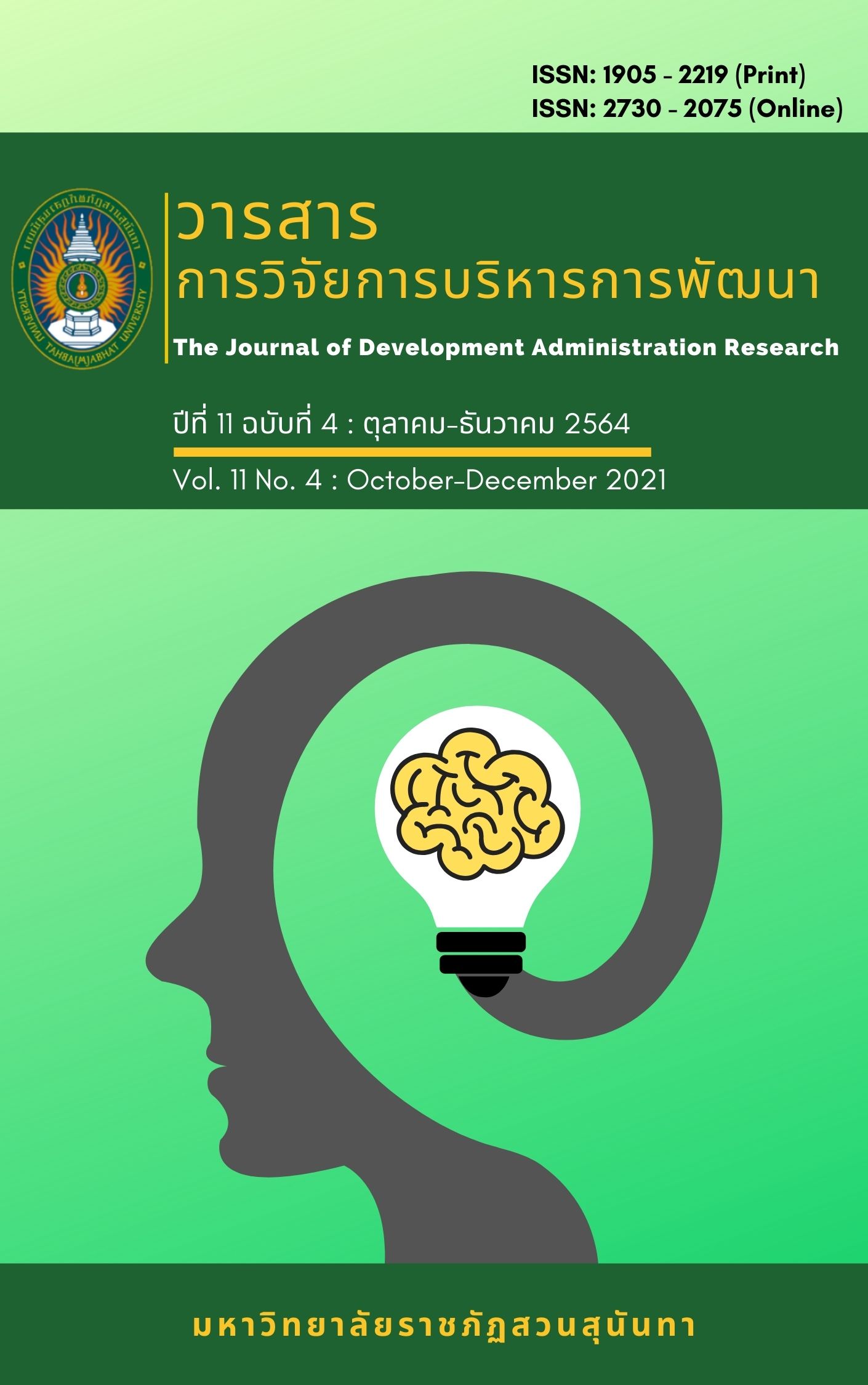อิทธิพลของโฆษณาออนไลน์แบบเฉพาะบุคคลที่มีต่อเจตนาซื้อ: การสำรวจอิทธิพลคั่นกลางของการรับรู้ประโยชน์ ความกังวลด้านความเป็นส่วนตัว และทัศนคติต่อแบรนด์
คำสำคัญ:
โฆษณาออนไลน์แบบเฉพาะบุคคล, การรับรู้ประโยชน์, ความกังวลด้านความเป็นส่วนตัว, ทัศนคติต่อแบรนด์, เจตนาซื้อบทคัดย่อ
โฆษณาออนไลน์แบบเฉพาะบุคคลมีประสิทธิภาพมากกว่าโฆษณาแบบดั้งเดิม เนื่องจากนำเสนอโฆษณาที่สอดคล้องกับความต้องการของผู้บริโภค การวิจัยครั้งนี้มีวัตถุประสงค์คือ 1) เพื่อศึกษาอิทธิพล ของโฆษณาออนไลน์แบบเฉพาะบุคคลที่มีต่อเจตนาซื้อผ่านการรับรู้ประโยชน์ ความกังวลด้านความเป็นส่วนตัว และทัศนคติต่อแบรนด์ 2) เพื่อศึกษาอิทธิพลของโฆษณาออนไลน์แบบเฉพาะบุคคลประเภทเน้นการส่งเสริมการขายที่มีต่อเจตนาซื้อผ่านการรับรู้ประโยชน์ ความกังวลด้านความเป็นส่วนตัว และทัศนคติต่อแบรนด์ 3) เพื่อศึกษาอิทธิพลของโฆษณาออนไลน์แบบเฉพาะบุคคลประเภทเน้นการให้ข้อมูลที่มีต่อเจตนาซื้อผ่านการรับรู้ประโยชน์ ความกังวลด้านความเป็นส่วนตัว และทัศนคติต่อแบรนด์ ผู้วิจัยวิเคราะห์ข้อมูลจากแบบสอบถามจำนวน 429 ชุด โดยใช้สถิติโมเดลสมการโครงสร้าง ผลการวิจัยพบว่า 1) โฆษณาออนไลน์แบบเฉพาะบุคคลมีอิทธิพลทางอ้อมเชิงบวกต่อเจตนาซื้อ ผ่านตัวแปรคั่นกลางคือการรับรู้ประโยชน์ ความกังวลด้านความเป็นส่วนตัว และทัศนคติต่อแบรนด์ 2) โฆษณาออนไลน์แบบเฉพาะบุคคลประเภทเน้นการส่งเสริมการขายมีอิทธิพลทางอ้อมเชิงบวกต่อเจตนาซื้อ ผ่านตัวแปรคั่นกลางคือการรับรู้ประโยชน์ ความกังวลด้านความเป็นส่วนตัว และทัศนคติต่อแบรนด์ 3) โฆษณาออนไลน์แบบเฉพาะบุคคลประเภทเน้นการให้ข้อมูลมีอิทธิพลทางอ้อมเชิงลบต่อเจตนาซื้อ ผ่านตัวแปรคั่นกลางคือการรับรู้ประโยชน์ ความกังวลด้านความเป็นส่วนตัว และทัศนคติต่อแบรนด์
เอกสารอ้างอิง
Abzari, M., Ghassemi, R. A., & Vosta, L. N. (2014). Analysing the effect of social media on
brand attitude and purchase intention: the case of Iran Khodro Company. Procedia
Social and Behavioral Sciences, 143, 822-826.
Aiolfi, S., Bellini, S., & Pellegrini, D. (2021). Data-driven digital advertising: benefits and risks of
online behavioral advertising. International Journal of Retail and Distribution
Management, 49(7), 1089-1110. doi: 10.1108/IJRDM-10-2020-0410
Baek, T. H., & Morimoto, M. (2012). Stay away from me. Journal of advertising, 41(1), 59-76.
doi: 10.2753/JOA0091-3367410105
Campos, L. (2021). Why marketing personalization is so important and how to use it.
Retrieved from Piesync website. https://www.piesync.com/blog/marketing- personalization/
Chakraborty, U., (2019). The impact of source credible online reviews on purchase
intention: The mediating roles of brand equity dimensions. Journal of Research in
Interactive Marketing, 13(2), 142-161. doi: 10.1108/JRIM-06-2018-0080
Chetioui, Y., Benlafqih, H., & Lebdaoui, H. (2020). How fashion influencers contribute to
consumers' purchase intention. Journal of Fashion Marketing and Management,
(3), 361-380. doi: 10.1108/JFMM-08-2019-0157
DAAT. (2021). Thailand digital advertising spend 2020-2021. Retrieved from DAAT
website. https://www.daat.in.th/digital-ad-spend.html
De Keyzer, F., Dens, N. & De Pelsmacker, P. (2021). How and when personalized advertising
leads to brand attitude, click, and WOM intention. Journal of Advertising.
doi: 10.1080/00913367.2021.1888339
Dodson, I. (2016). Digital marketing. New York: Wiley.
Eagly, A. H., & Chaiken, S. (1993). The psychology of attitudes. New York: Harcourt Brace
Jovanovich College Publishers.
Fortes, N., & Rita, P. (2016). Privacy concerns and online purchasing behaviour: Towards an
integrated model. European Research on Management and Business Economics,
(3), 167–176. doi: 10.1016/j.iedeen.2016.04.002
Gupta, R. (2016). Advertising principles and practice. New Delhi, India: S. Chand & Company.
He, A. Z., Cai, Y., Cai, L., & Zhang, Y. (2021). Conversation, storytelling, or consumer
interaction and participation? The impact of brand-owned social media content
marketing on consumers’ brand perceptions and attitudes. Journal of Research in
Interactive Marketing, 15(3), 419-440. doi: 10.1108/JRIM-08-2019-0128
Ho, R. (2014). Handbook of univariate and multivariate data analysis with IBM SPSS
(2nd ed.). New York: CRC Press.
Hong, S., & Park, I. (2020). SNS characteristics of mobile communication company influencing
brand attitude and purchase intention. Research in World Economy, 11(2), 82–89.
doi: 10.5430/rwe.v11n2p82
Huang, Y., Jim Wu, Y., Wang, Y., & Boulanger, N.C. (2011). Decision making in online
auctions. Management Decision, 49(5), pp. 784-800. doi: 10.1108/00251741111130850
Kudeshia, C., & Kumar, A. (2017). Social eWOM: does it affect the brand attitude and
purchase intention of brands?. Management Research Review, 40(3), 310-330.
doi: 10.1108/MRR-07-2015-0161
Kyguoliene, A., Zikiene, K., & Grigaliunaite, V. (2017). The influence of perceived benefits on
the satisfaction with the loyalty program. Engineering Economics, 28(1), 101–109.
doi: 10.5755/j01.ee.28.1.14635
Lantos, G. P. (2015). Consumer behavior in action: Real-life applications for marketing
managers. New York: Routledge
Lee, E. B., Lee, S. G., & Yang, C. G. (2017). The influences of advertisement attitude and brand
attitude on purchase intention of smartphone advertising, Industrial Management &
Data Systems, 117(6), 1011-1036. doi: 10.1108/IMDS-06-2016-0229
Leung, Y. (2013). Encyclopedia of behavioral medicine. New York: Springer.
Malhotra, N. K., Kim, S. S., & Agarwal, J. (2004). Internet users’ information privacy concerns
(IUIPC): The construct, the scale, and a casual model.” Information Systems
Research, 15(4), 336–55.
Morimoto, M. (2017). Personalization, perceived intrusiveness, irritation, and avoidance in
digital advertising. In Rodgers, S. & Thorson, E. (Eds.), Digital Advertising: Theory and
Research. (pp. 110-123). New York: Routledge.
Nesamoney, D. (2017). Personalized digital advertising: How data and technology are
transforming how we market. New Jersey: FT Press.
Nielsen Advertising Information. (2021). Media spending decrease 10% in Feb 2021. Retrieved
from TV Digital Watch website. https://www.tvdigitalwatch.com/nielsen-media-
spending-feb2021/
Nyheim, P., Xu, S., Zhang, L., & Mattila, A.S. (2015). Predictors of avoidance towards
personalization of restaurant smartphone advertising: A study from the Millennials’
perspective". Journal of Hospitality and Tourism Technology, 6(2), 145-159.
doi: 10.1108/JHTT-07-2014-0026
Papaioannou, T., Tsohou, A., & Karyda, M. (2021). Forming digital identities in social networks:
the role of privacy concerns and self-esteem. Information and Computer Security,
(2), 240-262. doi: 10.1108/ICS-01-2020-0003
Perri, S., & Bellamy, C. (2012). Principles of methodology: Research design in social science.
California: Sage.
Raji, R. A., Rashid, S., & Ishak, S. (2019). The mediating effect of brand image on the
relationships between social media advertising content, sales promotion content and
behaviuoral intention. Journal of Research in Interactive Marketing, 13(3), 302-330.
doi: 10.1108/JRIM-01-2018-0004
Rowles, D. (2018). Digital branding: A complete step-by-step guide to strategy, tactics, tools
and measurement (2nd ed.). New York: KoganPage.
Sari, D. K., Suziana, S., & Games, D. (2020). An evaluation of social media advertising for
Muslim millennial parents. Journal of Islamic Marketing, Vol. ahead-of-print No.
ahead-of-print. doi: 10.1108/JIMA-02-2020-0055
Schade, M., Piehler, R., Warwitz, C., & Burmann, C. (2018). Increasing consumers’ intention to
use location-based advertising. Journal of Product & Brand Management, 27(6), 661-
doi: 10.1108/JPBM-06-2017-1498
Shepherd, B. (2020). Everything you wanted to know about advertising & media: But were
too afraid to ask. Melbourne, Australia: Theodore & Partners.
Sreejesh, S., Anusree, M. R., & Mitra, A. (2016). Effect of information content and form on
customers’ attitude and transaction intention in mobile banking: Moderating role of
perceived privacy concern. International Journal of Bank Marketing, 34(7), 1092-1113.
doi: 10.1108/IJBM-07-2015-0107
Stokes, D., & Lomax, W. (2008). Marketing a brief introduction. London, England: Thomson
Learning.
Strycharz, J., Van Noort, G., Smit, E., & Helberger, N. (2019). Protective behavior against
personalized ads: Motivation to turn personalization off. Cyberpsychology, 13(2),
Article 1. doi: 10.5817/CP2019-2-1
Tuten, T. L. (2021). Social media marketing (4th ed.). California: Sage.
Van Reijmersdal, E. A., Rozendaal, E., Smink, N., Van Noort, G., & Buijzen, M. (2017). Processes
and effects of targeted online advertising among children. International Journal of
Advertising, 36(3), 396–414. doi: 10.1080/02650487.2016.1196904
Wu, P. C. S., & Wang, Y. (2011). The influences of electronic word-of-mouth message appeal and message source credibility on brand attitude. Asia Pacific Journal of
Marketing and Logistics, 23(4), 448-472. doi: 10.1108/13555851111165020
ดาวน์โหลด
เผยแพร่แล้ว
รูปแบบการอ้างอิง
ฉบับ
ประเภทบทความ
สัญญาอนุญาต
ลิขสิทธิ์ (c) 2021 มหาวิทยาลัยราชภัฏสวนสุนันทา

อนุญาตภายใต้เงื่อนไข Creative Commons Attribution-NonCommercial-NoDerivatives 4.0 International License.
บทความที่ได้รับการตีพิมพ์เป็นลิขสิทธิ์ของมหาวิทยาลัยราชภัฏสวนสุนันทา
ข้อความที่ปรากฏในบทความแต่ละเรื่องในวารสารวิชาการเล่มนี้เป็นความคิดเห็นส่วนตัวของผู้เขียนแต่ละท่านไม่เกี่ยวข้องกับมหาวิทยาลัยราชภัฏสวนสุนันทา และคณาจารย์ท่านอื่นๆ ในมหาวิทยาลัยฯ แต่อย่างใด ความรับผิดชอบองค์ประกอบทั้งหมดของบทความแต่ละเรื่องเป็นของผู้เขียนแต่ละท่าน หากมีความผิดพลาดใดๆ ผู้เขียนแต่ละท่านจะรับผิดชอบบทความของตนเองแต่ผู้เดียว




